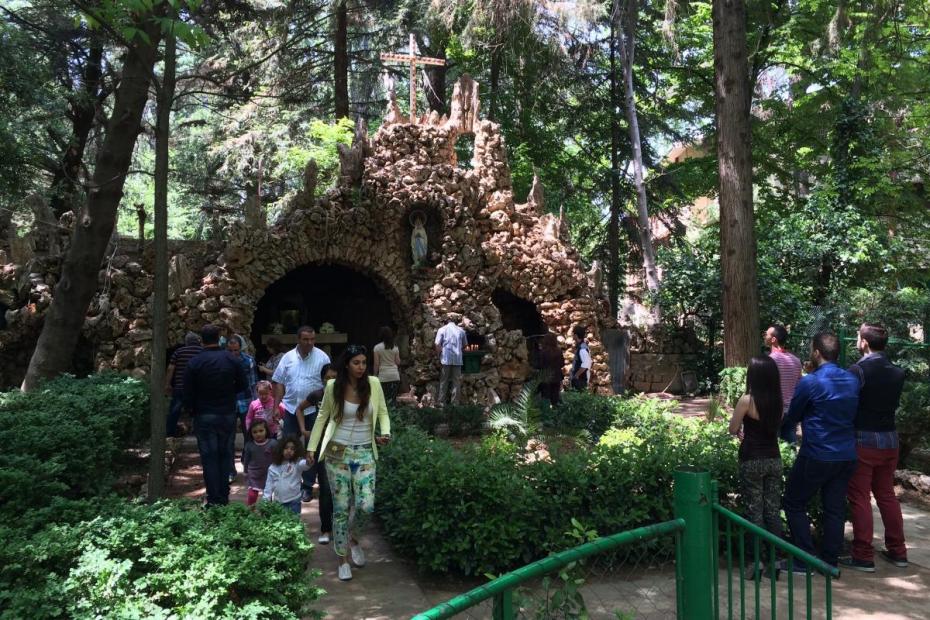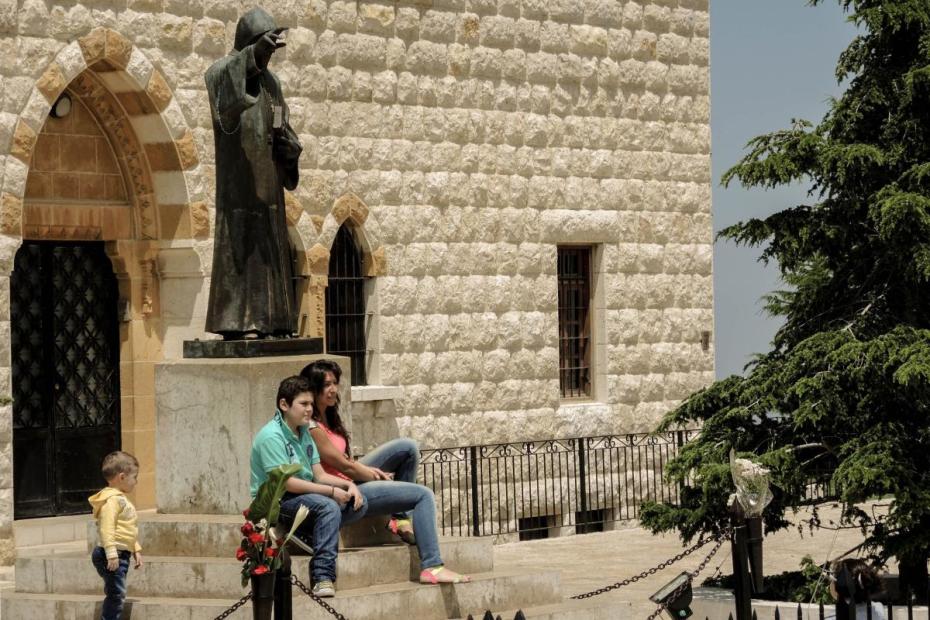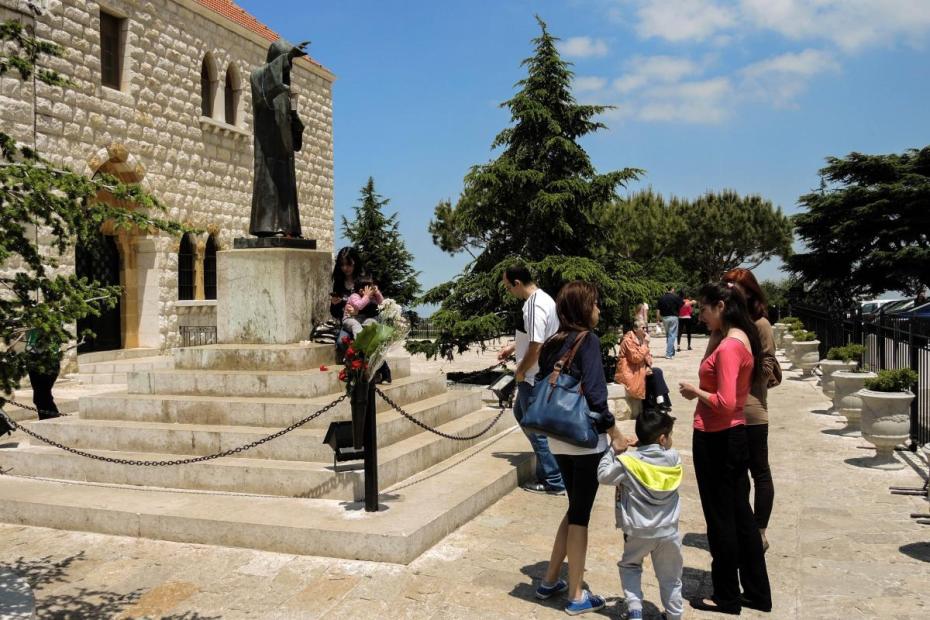Asked about the ways that Catholicism and contemporary Lebanese culture shape family life in Lebanon today, Catholics in Lebanon generally suggested that norms and ideals for the family are remarkably similar for Muslims and Christians.1
While many Lebanese women live outwardly modern lives, with equal access to education, the cultural attitude is still explicitly patriarchal, both at the macro and familial levels. Political power is overwhelmingly held by men.2 The confessional system integral to the Lebanese constitution[link] ensures that Lebanon is patriarchal in important religious ways. It grants the religious leaders of 18 legally recognized Muslim and Christian confessions—many of whom, in the Catholic and Orthodox Churches, bear the title of patriarch—determinative authority over important elements of people’s lives. At birth, on a permanent national identity card, children are assigned their father’s religious affiliation. Marriage, divorce and inheritance are adjudicated by appropriate confessional leaders, not by the state. There is no secular marriage or divorce. The authority of the religious leaders extends beyond this, too. The Patriarch of the Maronite Church, for instance, is a hugely significant cultural and moral leader.3
At the household level, the father is designated as the head of the household. Though Lebanese households were once intergenerational, most today, even in villages, are nuclear in structure. Adult children often stay in their parents’ home until marriage, but newly married couples move out of their parents’ homes to start their own families.4 In the Greek Melkite Catholic village in the Bekaa Valley she studied for decades, Nancy Jabbra reports that family members are still sometimes spoken of as belonging to the “house” (bayt) of the male head of the home.5 Families still show a preference for sons, who “represent the continuity of the household.”6 Single women are still generally expected to live with their families. The same can be true of adult sons.7
On the other hand, despite the explicit patriarchal understandings of the family, more contemporary understandings of what makes a marriage prevail. Marriage should be for love, and spouses should be mutually supportive of one another. The ideals of marriage and family life that Nancy Jabbra encountered in her study of a Melkite village in the Bekaa valley were consistently based on “love, respect and mutual understanding… mutual love and sincerity.”8 She did not, however, comment on any specifically gendered ways this mutuality was worked out or how it played out in terms of shared work at home.
Marriages were once commonly arranged by families.9 Today, families may still encourage potential matches, reinforcing that marriage is marriage into a family, not just to an individual, but especially in urban areas it is a choice left to individuals.10 For a variety of reasons, ranging from economics to education, age at first marriage has been increasing. Marriage is often typically deferred into the late 20s or early 30s.
“Mixed marriages [among members of different Christian churches] are frequent since social and cultural values, as well as political choices, differ very little.”11 But mixed marriage is not yet the norm. A 2001 study, perhaps a little outdated, found that 11.6% of Maronites found it acceptable to marry a Muslim, and 28.8% to marry a non-Maronite Christian.12
In 2004, Jabbra reported that among the Melkite Catholics in a Bekaa Valley farming village she studied, smaller families (two or four children) were perceived as now more ideal than in previous generations, primarily given the cost of raising children appropriately.13 More recent national data suggests that the median number of children nationally is now about two. Nationally, educational opportunities for women match those available for men, and Jabbra found strong support for women’s education in her village.14 When it came to work, however, she noted a tension, however, between perceptions that women are responsible for their home and child raising and their ability to work in jobs that did not conflict with home responsibilities. “The strongly-held belief that married women should put their husbands and children first has had a major impact on women’s employment.”15 Jabbra also noted that while women saw education as important for themselves and imagined few jobs to be inappropriate for women, they were “almost uniformly opposed to the idea of women becoming priests. It wasn’t ‘nice,’ they couldn't imagine a woman giving Communion… Women could become nuns, they said.”16
The confessional system, which allocates political power according to the size of various religious communities, gives religious and ethnic leaders an incentive to encourage their members to marry and have children. Given the strain of the financial crisis in Lebanon, the Maronite League, among other religio-political groups, has sponsored large-scale weddings to make it possible for more couples to marry.17
Civil divorce is unavailable in Lebanon, and the annulment system in the Church is expensive and difficult, Lebanese Maronites reported. The end result, some said, is a high level of separations without divorce.
As befits a culture that has one foot in Europe and another in the Arab world, Lebanon is in an in-between place when it comes to LGBTQ acceptance. Rallies and meeting spaces are relatively visible in Beirut, and the city is seen as one of the friendlier places in the Arab world, but rallies and Pride events have also triggered intense pushback at times.
Gendered religious involvement, directed for the sake of the family
Jabbra points out that in the Melkite, Bekaa Valley she calls ‘Ain al-Qasis, women are much more likely than men to be involved in religious organizations and practices.18 In the village, there is a priest in charge, but “almost all religious organizations are composed exclusively of women: the Saint Rita sisterhood, the Our Lady of Perpetual Help sisterhood, and the Sacred Heart of Jesus organization… those who first began organizing May devotions were women, the nuns organize First Communion and it is women who make the samdis [small tables set up in front of houses on the route of the procession] for Corpus Christi.”19
Women may be more involved than men, but a good deal of religiosity remains focused on family well-being. One interesting family-based religious phenomenon is the custom in ‘Ain al-Qasis of celebrating a family feast day, a combination of Catholic Mass and home celebration.20 The custom is particular to that region of the Bekaa Valley. A family—a nuclear household (extended family members attend as guests)—chooses a saint, almost always a male saint and often one whose name is tied to a male member of the household. The rituals connect the family, not the individual, to the saint’s protection, and offer the family a certain standing in the village. “A family registers its day with the village priest, dedicating itself or a member to a patron (the saint) for supernatural protection.”21 In a sense, by registering the event, a public saint becomes a familial one, the protector of the family, and the feast day of a Saint Joseph or Saint Michael becomes “the feast of the house of so-and-so”.22
When a family first celebrates the feast, they make an offering at Mass of qurbān (the slightly leavened round of bread that is used for the liturgy, stamped with ‘Christ conquers’ on top in Greek) which the priest blesses; then the priest announces the feast.”23 In subsequent years, the family offers qurbān and an image of the saint, and the priest prays for the family members, dead and living. Following Mass, the family opens its home for a reception of zihbi—cookies, candy and coffee. The greetings at the reception are formalized, including “May you always enjoy good health,” “God willing, you’ll always celebrate the feast,” “God bless the host,” “God willing you’ll always experience joy,” and “May (all your children) marry in your lifetime” indicate something about the traditional and ongoing values of the community.
- 1The articles about Lebanon on this site are based on in-person research and conversations in several parts of Lebanon in 2014 and 2022, supplemented by the various sources cited here.
- 2See William W. Harris, Lebanon: A History, 600-2011, Studies in Middle Eastern History (Oxford University Press, 2012), 21-24.
- 3The Maronite Patriarch’s power is undoubtedly political as well, but in normal times is said to depend on his staying above too much of the hurly-burly of politics.
- 4This is confirmed by Nancy Jabbra in her study since the 1970s of a single village in the Bekaa valley. Nancy Jabbra, Women and Gender in a Lebanese Village: Generations of Change (Leiden, Brill, 2021), 55-56, 58.
- 5Jabbra, Women and Gender in a Lebanese Village, 38-9.
- 6Nancy W. Jabbra, “Family Feast Observances in a Lebanese Melkite Village,” Middle East Critique 25, no. 2 (2016): 147-161.
- 7Cf. Jabbra, 48.
- 8Nancy W. Jabbra, “Family Change in Lebanon’s Biqa Valley: What Were the Results of the Civil War?” Journal of Comparative Family Studies 35, no. 2 (2004): 266-7.
- 9I have encountered Lebanese in their 50s and 60s who reported this, somewhat confidentially, about their marriages.
- 10Jabbra, Women and Gender in a Lebanese Village, 52-3.
- 11Boutros Labaki, “The Christian Communities and the Economic and Social Situation in Lebanon,” Christian Communities in the Arab Middle East: The Challenge of the Future, ed. Andrea Pacini (Oxford: Clarendon, 1998) 232.
- 12Simon Haddad, “A Survey of Maronite Christian Social-Political Attitudes in Postwar Lebanon,” Islam and Christian-Muslim Relations 12, no. 4 (2001): 471.
- 13Jabbra, “Family Change in Lebanon’s Biqa Valley,” 262.
- 14Jabbra, Women and Gender in a Lebanese Village, 69.
- 15Jabbra, Women and Gender in a Lebanese Village, 86.
- 16Jabbra, “Family Change in Lebanon’s Biqa Valley,” 264.
- 17Ben Hubbard “Here Comes the Bride. And the Bride. And the Bride. Mass Weddings Boom in Lebanon” The New York Times, Sept. 15, 2019, https://www.nytimes.com/2019/09/15/world/middleeast/lebanon-weddings.html.
- 18The village name is a pseudonym.
- 19Nancy W. Jabbra, “Globalization and Christian Practice in Lebanon's Biqa' Valley,” Middle East Critique, 18, no. 3 (2009): 298, DOI: 10.1080/19436140903237079.
- 20Jabbra, “Family Feast Observances in a Lebanese Melkite Village,” 147-161.
- 21Jabbra, “Family Feast Observances in a Lebanese Melkite Village,” 151.
- 22Jabbra, “Family Feast Observances in a Lebanese Melkite Village,” 155-6, 160. The custom may be handed down from one household of the next generation taking it over from the prior one.
- 23Jabbra, “Family Feast Observances in a Lebanese Melkite Village,” 151.


